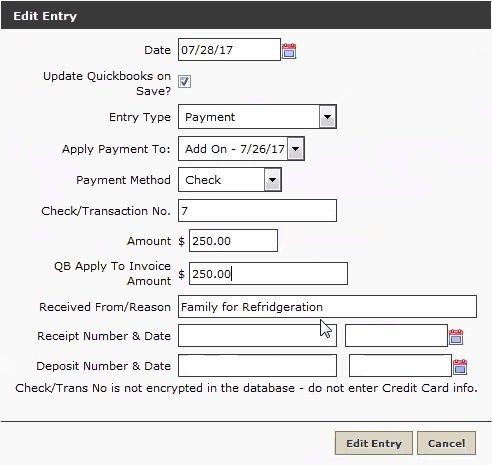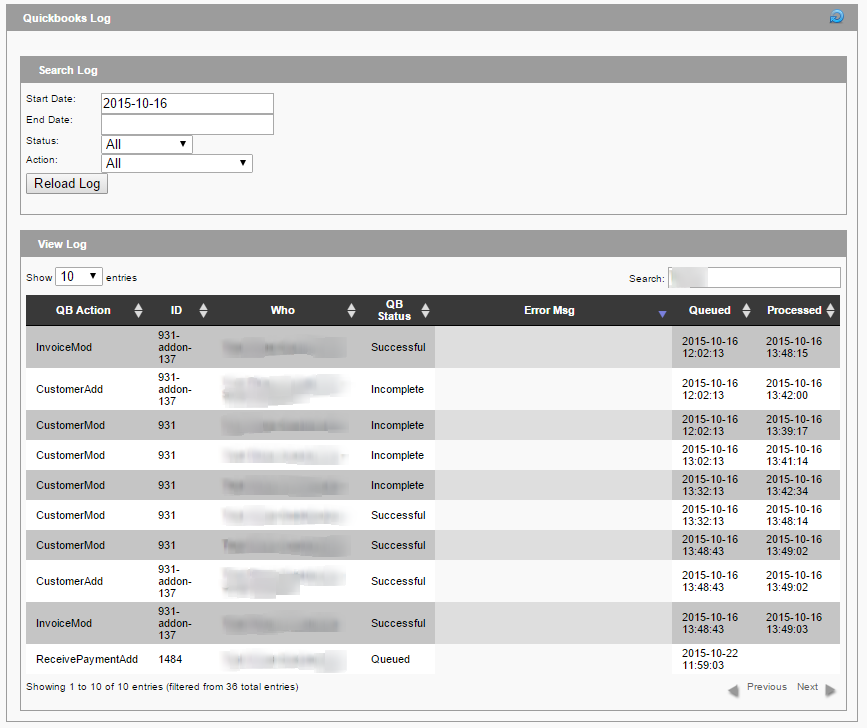As a default in the Quickbooks integration, your system will automatically enable all Pre-Need and At-Need Contracts to “Update Quickbooks on Save”. At this time, a customer-add and invoice-add command will be queued to push to QuickBooks until the Web Connector runs. Should wish to change your default contract push settings, for At-Need and/or Pre-Need Contracts, please visit the Miscellaneous Configuration in your Configuration Wizard.
Should you wish for a particular contract not to push to Quickbooks, there is a small checkbox on the contract screen to “Update Quickbooks on Save” that you can disable..

This checkbox also controls whether future amendments to this account (changes to the contract, payments etc) will push to QuickBooks or not. If you need to de-activate the integration for a particular contract after the invoice has already been pushed through to Quickbooks (for example, if you had to manually adjust something in Quickbooks), you can disable this box at any time to turn off the integration for this client.
Making an Entry on the Account
When making an entry towards the account in your FrontRunner system, the entry screen will have additional options just for your Quickbooks connection.
Each time an entry is made towards a contract, whether it be a Payment, Down Payment, Late Fee, Additional Discount, or a Refund to Family, it too will be defaulted to “Update Quickbooks on Save” and be queued to push to Quickbooks until the Web Connector runs. Should you wish to disable the entry from being updated to Quickbooks, you may disable the “Update Quickbooks on Save” prior to saving.
Entry Types
Payment & Down Payment Entries
These entries will be pushed as payment entries in Quickbooks. By default these entries will be applied to the Customer and not the Invoice.
Adjustment & Late Fee Entries
These entries will push as line items on your Quickbooks invoice. You may establish which item in Quickbooks it links to under the Configuration Wizard Step 3b. Contract Line Configuration.
Refund to Family Entries
These entries will push over as a Checks in Quickbooks. In order for these to successfully push over, you will need to configure the bank account in which these will be connected to. You may establish this in the Configuration Wizard Step 3b Contract Line Configuration.
‘Amount’ and ‘QB Apply to Invoice Amount’
When making an entry it is important to remember that although in FrontRunner you can make entries greater than the Contract Amount, Quickbooks does not allow an Invoice to receive payments great than it.
Therefore your entry screen will give you the flexibility to apply a certain portion to the Invoice (if needed) and the remaining balance will just get added to the Account. As a default the amount you enter to the ‘Amount’ field will also pre-populate to the ‘QB Apply to Invoice Amount’. Only in the situations when you cannot apply the full amount to the Invoice you can adjust.
This will allow payments larger than the Contract Amount or Amount Due to be entered into FrontRunner and successfully push over to Quickbooks.

Once the entry is saved, your entry log on your Accounts tab will detail the Quickbooks status of each payment.

Quickbooks Sequence:
The Quickbooks integration works in a sequence that can often help you determine the cause of an error. The following is the order that item(s) are queued to Quickbooks:
1. Customer Add
2. Customer Modify OR Invoice Add
3. Invoice Modify or Payment Add
4. Payment Modify
Quickbooks Log
The Quickbooks Log, found under System Settings > Arranging Director Admin > View Logs, will show you the record of all pieces of information that have been pushed (Queued) from FrontRunner to the Web Connector, as well as the status of the items pushing to Quickbooks after you have run your Web Connector.

QB Action = Action being made from FrontRunner.
CostomerAdd = New Customer (deceased) Add
CustomerMod = Previous Customer (deceased) Modification
InvoiceAdd = New Invoice/Contract Add
InvoiceMod = Previous Invoice Added being Modified
ReceivedPaymentAdd = New Payment Add
ReceivedPaymentMod = Previous Payment Add being Modified
ID = Unique ID code per Customer (deceased)
ID may also include if the particular QB Action is being made towards a Contract Add-On.
Who = Customer (Deceased) or Sub Customer (Buyer) Name
QB Status = Real time status of QB Action
Queued
Successful
Error
Error Msg = Description of QB Action if QB Status was Errored
Queued = Time stamp QB Action was originally queued from FrontRunner
Processed = Time stamp the QB Action’s was updated from Web Connector
For assistance with troubleshooting your Quickbooks Log, visit Quickbooks Troubleshooting.
Need more help with this?
Don’t hesitate to contact us here.
